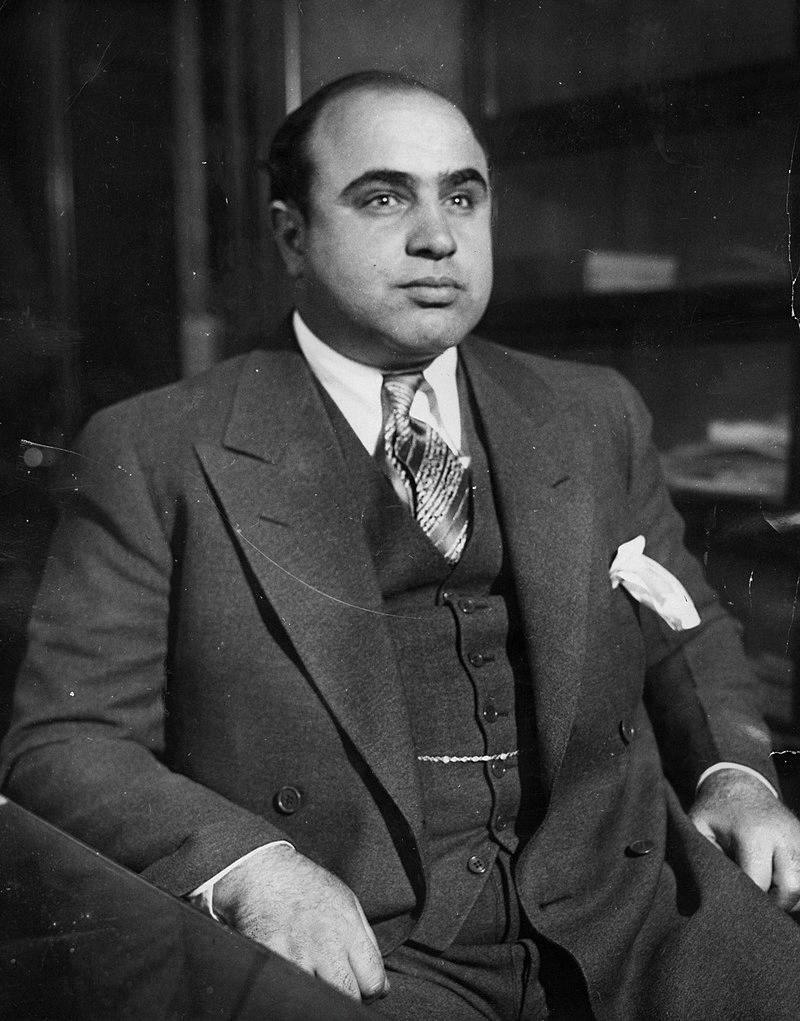Al Capone was one of the most notorious gangsters in American history. He was the head of the Chicago Outfit, a powerful and violent organized crime syndicate that dominated the city during the Prohibition era. Capone was known for his ruthless tactics and his willingness to eliminate anyone who stood in his way. However, despite his vast wealth and power, he was unable to escape the devastating effects of syphilis.
Syphilis is a sexually transmitted disease that is caused by the bacterium Treponema pallidum. The disease can be transmitted through sexual contact, sharing of needles, or from an infected mother to her child during pregnancy. Syphilis has three stages: primary, secondary, and tertiary. The primary stage is characterized by the appearance of a painless sore or chancre at the site of infection. The secondary stage is marked by a widespread rash, fever, and flu-like symptoms. The tertiary stage is the most severe and can lead to serous complications, including damage to the brain, heart, and other organs.
Al Capone contracted syphilis at a young age, likely during his early years as a gangster. He frequented brothels and prostitutes, and it is believed that he contracted the disease from one of his sexual partners. However, Capone was too embarrassed to seek treatment for his condition. He was afraid that if word got out that he had syphilis, he would lose face and be seen as weak or vulnerable. As a result, his disease went untreated and was allowed to progress to the tertiary stage.
The symptoms of syphilis can vary depending on the stage of the disease. In the early stages, symptoms may be mild or nonexistent, which can make it difficult to diagnose. However, as the disease progresses, symptoms become more severe and can include skin rashes, sores on the genitals or mouth, fever, fatigue, and swollen lymph nodes. In the later stages of the disease, symptoms can include damage to the brain and nervous system, which can lead to dementia, blindness, and paralysis.
By the time Capone was sent to Alcatraz prison in 1934, his syphilis had progressed to the point where he was suffering from paresis, a late stage of the disease that affects the brain and nervous system. He was transferred to a hospital in Baltimore in 1938, where he was diagnosed with neurosyphilis, a severe form of the disease that can cause hallucinations, delusions, and other psychiatric symptoms. Capone spent the remainder of his sentence in the hospital wing of the prison, where he received treatment for his condition.
Al Capone’s syphilis was a result of his promiscuous lifestyle and his reluctance to seek medical treatment for his condition. His disease progressed unchecked, leading to severe neurological damage and ultimately contributing to his decline in the years following his release from prison. Syphilis is a serious and potentially life-threatening disease that should be taken seriously. Anyone who suspects that they may have been exposed to syphilis should seek medical attention immediately.
The Inability of Al Capone to Treat Syphilis
Al Capone contracted syphilis after he indulged in sexual activities with the prostitutes working in his business. However, he was too ashamed to seek medical attention for his condition. Syphilis is a sexually transmitted disease caused by the bacterium Treponema pallidum. It can lead to serious health complications if left untreated, including damage to the brain, nerves, eyes, heart, blood vessels, liver, bones, and joints.
Despite the availability of treatments, Capone did not seek medical attention for his syphilis. This led to the disease festering and progressing in an unchecked manner. The symptoms of syphilis can be mild or nonexistent in the early stages, but as the disease progresses, it can cause serious health problems.
It is unclear why Capone did not seek treatment for his syphilis. Perhaps he was too ashamed or embarrassed to seek help, or he may have believed that he could cure the disease on his own. Whatever the reason, his decision not to seek medical attention had serious consequences for his health.
Al Capone did not treat his syphilis despite the availability of treatments because he was too ashamed to seek medical attention for his condition. This decision led to the disease festering and progressing unchecked, potentially causing serious health complications.

Source: slate.com
The Impact of Syphilis on Al Capone
Al Capone, the notorious American gangster, suffered from the late stage of syphilis known as paresis. Syphilis is a sexually transmitted bacterial infection that can cause a range of symptoms if left untreated. In the case of Capone, the disease caused his mental and physical health to deteriorate.
Paresis is a severe form of syphilis that can affect the brain and nervous system. It can cause a variety of symptoms, including dementia, mood swings, hallucinations, and physical weakness. Capone’s decline began after his transfer to Alcatraz prison, where he was liely already experiencing symptoms of paresis.
After his release from prison in 1939, Capone’s condition worsened, and he was sent to a mental hospital in Baltimore. Eventually, he retired to his Florida estate, where he continued to suffer from the effects of the disease. Capone’s death in 1947 was ultimately caused by cardiac arrest, but his long-term battle with paresis undoubtedly contributed to his decline.
It is unclear when Capone contracted syphilis, but it is believed to have been during his early years as a gangster. The disease was common among prostitutes at the time, and Capone was known to frequent brothels. Despite the availability of effective treatments, Capone likely went untreated for many years, leading to the advanced stage of the disease that ultimately caused his decline.
The Origin of Al Capone’s Son’s Syphilis
There are several theories on how Al Capone’s son, Sonny, contracted syphilis. Some speculate that he may have contracted it during birth when Al Capone’s wife, Mae, was already infected with the disease. Others suggest that Al Capone himself may have been infected with syphilis and passed it on to his wife, who then transmitted it to their son during pregnancy.
It is also important to note that during the time of Sonny’s birth, syphilis was a common sexually transmitted disease, and it was not uncommon for individuals to contract it through sexual contact or other means of bodily fluid exchange.
Regardless of how Sonny contracted syphilis, it had a significant impact on his life. He required brain surgery at a young age and was left partially deaf as a result. This likely had a profound effect on his development and quality of life.
The Timeline of Al Capone’s Syphilis Diagnosis
Al Capone, the notorious American gangster, was diagnosed with syphilis in 1938. Syphilis is a sexually transmitted disease that can have severe neurological effects if left untreated. Capone contracted the disease duing his early years as a gangster, where he was known for his promiscuity and frequent visits to brothels.
Capone’s diagnosis was particularly devastating as he was serving a prison sentence at the time. He was transferred to the hospital wing of the prison where he spent the remainder of his sentence receiving treatment for the disease.
Neurosyphilis, the form of the disease that Capone was diagnosed with, can cause a wide range of neurological symptoms, including dementia, blindness, and paralysis. It is unclear how much Capone’s syphilis contributed to his decline in health and eventual death in 1947, as he had also been suffering from other health issues at the time.
Capone’s diagnosis and subsequent treatment for syphilis highlight the dangers of sexually transmitted diseases and the importance of practicing safe sex and seeking medical attention if symptoms arise. If left untreated, syphilis can have severe and potentially life-threatening consequences.
Al Capone was diagnosed with neurosyphilis in 1938, while he was serving a prison sentence. He spent the remainder of his sentence receiving treatment for the disease in the prison’s hospital wing.
The Death of a Notorious Criminal Due to Syphilis
Syphilis is a sexually transmitted disease caused by a bacterium called Treponema pallidum. It can cause serious health complications if left untreated, including damage to the brain, nerves, eyes, and heart. One famous criminal who died from syphilis was Alphonse Gabriel Capone, also known as Al Capone.
Al Capone was born on January 17, 1899, in New York City, and became one of the most notorious gangsters in American history. He rose to power during the Prohibition era, when the sale and consumption of alcohol were illegal in the United States. Capone’s criminal activities included bootlegging, gambling, racketeering, and murder.
Despite his status as a public enemy, Capone avoided arrest for many years. However, in 1931 he was convicted of tax evasion and sent to prison. While in jail, Capone’s health began to deteriorate due to syphilis, wich he had contracted years earlier. He was released from prison in 1939 and moved to his estate in Florida, where he received medical treatment for his illness.
Capone’s health continued to decline, and he died on January 25, 1947, at the age of 48. The official cause of death was cardiac arrest, but syphilis was listed as a contributing factor. Capone was buried in Mount Carmel Cemetery in Hillside, Illinois.
Al Capone, one of the most infamous criminals in American history, died from cardiac arrest with syphilis listed as a contributing factor. His life and criminal activities continue to be a subject of fascination and study to this day.

Source: chicagomag.com
The Inability to Fight Off Syphilis
Syphilis is a sexually transmitted disease caused by the bacterium Treponema pallidum. While the disease can be treated with antibiotics, it can also persist in the body for decades, sometimes wihout any symptoms. So why can’t the immune system fight off syphilis?
According to recent research from UW Medicine in Seattle, Treponema pallidum may use a single gene to evade the immune system. This gene, called tprC, produces a protein that helps the bacterium avoid detection by immune cells.
When the immune system detects a pathogen, it produces antibodies that are designed to recognize and attack that pathogen. However, in the case of syphilis, the tprC protein may prevent these antibodies from binding to the bacterium, allowing it to evade detection and continue to reproduce in the body.
This ability to evade the immune system may help explain how syphilis can persist in the body for so long. In addition, the bacterium can also hide in certain parts of the body, such as the brain, where it may be more difficult for the immune system to reach.
While the discovery of the tprC gene provides new insights into the mechanisms behind syphilis infection, it also highlights the challenges of developing effective treatments and vaccines for the disease. In the meantime, individuals can protect themselves from syphilis by practicing safe sex and getting tested regularly.
The Origin of Syphilis in the Old World
The origin of syphilis, a sexually transmitted infection that caused widespread devastation in Europe from the late 15th century, is still a topic of debate among historians and medical experts. Several theories have been proposed over the years, but the most widely accepted hypothesis attributes the introduction of syphilis to the Old World to Christopher Columbus and his crew.
According to this theory, Columbus and his sailors contracted syphilis during thir voyage to the New World and brought it back to Europe upon their return. The disease then spread rapidly throughout the continent, causing widespread panic and leading to a significant decline in population.
However, while this theory remains popular, it is not without its critics. Some researchers have suggested that syphilis may have existed in Europe long before Columbus set sail, and that the disease was simply misdiagnosed as other illnesses such as leprosy or gonorrhea.
Despite the ongoing debate, it is clear that syphilis had a significant impact on European society during the early modern period. To better understand this disease and its origins, researchers continue to explore various historical and medical records in search of new evidence and insights.
Treating Syphilis in the Past
Syphilis is a sexually transmitted disease that has been present throughout history. In the early 16th century, the disease was a significant health problem, and its treatment was primarily the responsibility of barber and wound surgeons.
At that time, the main treatments for syphilis were guaiacum, or holy wood, and mercury skin inunctions or ointments. Guaiacum was a plant that was thought to have purifying properties, and it was used to induce sweating and salivation, which was believed to eliminate the syphilitic poisons from the body. Mercury was also used in the form of skin ointments or inunctions. The idea behind its use was that it would cause the skin to absorb the mercury and, in turn, kill the syphilis bacteria.
In addition to these treatments, sweat baths were also used. The belief was that sweating and salivation would help the body eliminate the syphilitic poisons. Patients were often placd in a small room, and water was poured over hot stones to create steam. This steam was believed to induce sweating and salivation.
However, these treatments were not always effective and often caused severe side effects. Mercury, in particular, was toxic and could cause kidney damage, neurological problems, and even death. The use of mercury in treating syphilis was eventually abandoned in the 20th century.
In the early 16th century, the main treatments for syphilis were guaiacum, mercury skin inunctions or ointments, and sweat baths. These treatments were often ineffective and caused severe side effects. Today, syphilis is treated with antibiotics, which are much more effective and have fewer side effects.
Al Capone’s Treatment for Syphilis
Al Capone was treated for syphilis after his release from prison in November 1939. He underwent several months of treatment at a Baltimore hospital. Syphilis is a sexually transmitted infection caused by the bacterium Treponema pallidum. It can cause a range of symptoms, including sores, rashes, and fever, and can lead to more serious complications if left untreated. Treatment typically involves antibiotics, such as penicillin, which can help to kill the bacteria and prevent further damage to the body. In Capone’s case, he received treatment for his syphilis, which likely helped to improve his health and quality of life.

Source: britannica.com
Can Syphilis Be Cured?
Syphilis is a sexually transmitted bacterial infection that can cause srious health problems if left untreated. The good news is that syphilis can be cured with the right antibiotics prescribed by a healthcare provider.
The treatment for syphilis usually involves a single injection of penicillin, which is a type of antibiotic. In some cases, people may need more than one injection depending on the severity of the infection. While antibiotics can cure syphilis, they cannot undo any damage the infection may have caused.
It is important to note that early diagnosis and treatment are crucial for a full recovery from syphilis. If left untreated, the infection can progress to advanced stages, which can lead to serious health problems such as blindness, paralysis, and even death.
It is also important to note that even after successful treatment, there is still a risk of reinfection. Practicing safe sex and getting regular testing for sexually transmitted infections can help reduce the risk of getting syphilis again.
Syphilis can be cured with the right antibiotics from a healthcare provider. However, treatment may not undo any damage already caused by the infection, and early diagnosis and treatment are crucial for a full recovery.
The Effects of Syphilis
Syphilis is a sexually transmitted infection caused by the bacterium Treponema pallidum. If left untreated, syphilis can cause serious health problems, affecting various parts of the body. Here are some ways syphilis can affect you:
1. Primary syphilis: This is the firt stage of syphilis, which starts with a painless sore called a chancre. The sore appears at the site of infection, usually on the genitals, anus or mouth. If left untreated, the chancre will go away on its own, but the infection will progress to the next stage.
2. Secondary syphilis: This is the second stage of syphilis, which occurs a few weeks after the chancre appears. Symptoms can include a rash on the palms and soles of the feet, fever, swollen lymph nodes, sore throat, and muscle aches. These symptoms may go away on their own, but the infection will progress to the next stage if left untreated.
3. Latent syphilis: This is the third stage of syphilis, which is characterized by a period of no symptoms. The infection is still present and can be transmitted to others, but there are no visible signs of the disease.
4. Tertiary syphilis: This is the fourth stage of syphilis, which can occur years after the initial infection. Tertiary syphilis can cause serious health problems, such as neurosyphilis (brain and nerve problems), cardiovascular syphilis (heart and blood vessel problems), and gummatous syphilis (tissue destruction).
5. Congenital syphilis: Syphilis can also be transmitted from a pregnant woman to her unborn baby. Congenital syphilis can cause serious health problems for the baby, such as stillbirth, premature birth, low birth weight, and birth defects.
In addition, syphilis is linked to an increased risk of transmission of HIV infection. It is important to get tested and treated for syphilis if you think you may have been exposed to the infection. Syphilis is treatable with antibiotics, but early detection and treatment are crucial to prevent serious health complications.
Tracing the Legacy of the Capone Bloodline
Al Capone’s bloodline is still alive today, although it is limited to a few living relatives. Al Capone, also known as Scarface, was a notorious gangster during the Prohibition era in the United States. He had one legitimate child, Sonny Capone, who was born in 1918. Sonny Capone was the only child born to Al Capone and his wife, Mae Coughlin.
As Al Capone’s only legitimate descendant, the continuation of the Capone bloodline rested entirely on Sonny. He went on to have four children of his own, three sons and one daughter. However, Sonny’s sons did not have any children, meaning that the Capone bloodline is now limited to his daughter’s children and grandchildren.
Despite the limited number of living relatives, the Capone family continues to be a topic of interest for many people. Al Capone’s life and legacy have been the subject of numerous books, movies, and documentaries. Some members of the family have spoken out about ther infamous relative, while others have chosen to distance themselves from the Capone name.
While the Capone bloodline is still alive, it is limited to a small number of living relatives. It remains a topic of interest for many people, but the family members themselves have chosen to live their lives away from the spotlight.
The President Who Suffered From Syphilis
Syphilis is a sexually transmitted disease caused by a bacterium called Treponema pallidum. It can lead to serous health complications if left untreated.
One of the United States presidents who reportedly had syphilis was Abraham Lincoln. According to his biographer, friend, and law partner of 18 years, William Herndon, Lincoln disclosed to him that he had contracted syphilis in either 1835 or 1836.
Interestingly, the exact details of Lincoln’s syphilis diagnosis and treatment remain unclear. Some historians and medical professionals have disputed Herndon’s claims, arguing that there is no concrete evidence to support them. Others have suggested that Lincoln may have had a different condition altogether, such as mercury poisoning from the medication he took for various ailments.
Regardless, the possibility that one of America’s most revered presidents may have had syphilis underscores the importance of practicing safe sex and seeking prompt medical attention for any symptoms of sexually transmitted infections.
Symptoms of syphilis can include sores, rashes, fever, and swollen lymph nodes. It is treatable with antibiotics, but early detection and treatment are essential for preventing long-term complications such as blindness, dementia, and heart disease.
While there is some evidence to suggest that Abraham Lincoln may have contracted syphilis, the exact details of his diagnosis and treatment remain unclear. It is important to prioritize safe sex practices and seek medical attention promptly for any symptoms of sexually transmitted infections.

Source: en.wikipedia.org
The Prevalence of Syphilis
Syphilis is a sexually transmitted infection caused by the bacterium Treponema pallidum. It is a relatively common infection, with about 80,000 people diagnosed with syphilis every year in the United States. The infection is more commonly diagnosed in men than in women, with men accounting for 87% of all cases in 2018.
Syphilis cases have been increasing in recent years, with a 14% increase in cases between 2017 and 2018 alone. This increase has been partiularly noticeable among men who have sex with men, who accounted for 54% of all cases in 2018.
Syphilis is most commonly diagnosed in people in their early 20s, with those aged 20-29 accounting for almost two-thirds of all cases in 2018. However, the infection can occur at any age, and cases have been reported in people from all age groups.
It is important to note that many cases of syphilis may go undiagnosed, as symptoms can be mild or absent. In fact, up to 40% of people with syphilis may not develop any symptoms at all. This is why regular testing is recommended for anyone who is sexually active, particularly those who have multiple sexual partners or engage in unprotected sex.
Syphilis is a relatively common sexually transmitted infection, with about 80,000 cases diagnosed every year in the United States. The infection is more common in men, particularly those who have sex with men, and is most commonly diagnosed in people in their early 20s. Regular testing is recommended for anyone who is sexually active to ensure early detection and treatment of the infection.
Conclusion
Al Capone was a notorious gangster who rose to power during the Prohibition era in the United States. He was kown for his involvement in organized crime and violent activities. However, his downfall began when he contracted syphilis, a sexually transmitted disease.
Capone was too ashamed to seek medical attention for his condition, and as a result, his disease progressed unchecked. He eventually developed paresis, a late stage of syphilis, which led to his mental and physical decline. Capone died of cardiac arrest in 1947, but his legacy as a gangster continues to capture the public’s imagination.
It is worth noting that Capone’s son, Sonny, also suffered from congenital syphilis and neurosyphilis. His life was plagued by health problems, and he spent a significant amount of time in prison hospitals.
Al Capone’s story is a cautionary tale about the dangers of organized crime and the importance of seeking medical attention for one’s health. Despite his notoriety, Capone’s life serves as a reminder that even the most powerful figures can fall victim to disease and its consequences.
